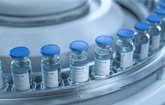AUSTIN, Texas and TOKYO, Oct. 28, 2025 /PRNewswire/ -- According to DataM Intelligence, the Glucagon-like Peptide-1 (GLP-1) Analogues Market is witnessing a transformative expansion, driven by soaring demand for effective obesity management and type 2 diabetes therapies. The GLP-1 Analogues Market Size, valued at USD 62.81 billion in 2024, is projected to reach an astounding USD 299.08 billion by 2033, growing at a CAGR of 17.6% during the forecast period (2025–2033).
This explosive growth is primarily attributed to the global success of blockbuster drugs such as Ozempic, Wegovy, Mounjaro, and Rybelsus, which have revolutionized chronic metabolic disease management. GLP-1 analogues, known for mimicking the natural incretin hormone to enhance insulin secretion and suppress appetite, are now being increasingly prescribed beyond diabetes-particularly for obesity and cardiovascular benefits.
Market Dynamics: The Dual Impact of Diabetes and Obesity Epidemics
The GLP-1 analogues market is being reshaped by intersecting public health trends-the global rise in obesity and the increasing prevalence of type 2 diabetes. According to DataM Intelligence, over 1 billion people worldwide are now classified as obese, while diabetes affects over 540 million adults globally, intensifying the need for multi-target therapeutic options.
Key Market Drivers Include:
- Rapid uptake in obesity management: GLP-1 receptor agonists, initially approved for diabetes, are now widely used off-label for weight reduction and appetite regulation.
- Strong clinical outcomes: Trials demonstrating reduced cardiovascular risk and improved metabolic parameters have strengthened physician adoption rates.
- Expansion into oral formulations: Novel oral GLP-1 drugs, such as semaglutide tablets, are enhancing patient compliance and broadening the consumer base.
- Pipeline diversification: Multiple pharmaceutical players are investing in dual and triple agonists (GLP-1/GIP/GCG) to improve efficacy and tolerability profiles.
- Policy and reimbursement support: Several governments have begun to include obesity treatment within reimbursable health programs, further accelerating global access.
Download PDF Brochure: https://www.datamintelligence.com/download-sample/glucagon-like-peptide-1-analogues-market
Browse in-depth TOC on 'GLP-1 Analogues Market'
79 – Tables
73 – Figures
215 – Pages
Market Segmentation Analysis
The global GLP-1 analogues market is segmented By Product, By Type, By Route of Administration, By Application, and By Distribution Channel.
By Product
The semaglutide-based formulations (marketed under Ozempic, Wegovy, and Rybelsus) dominated the product landscape in 2024, accounting for over 45% of global market share, equivalent to approximately USD 28 billion. These drugs have set new standards for efficacy, with average weight loss of 15–20% observed in clinical trials.
Liraglutide-based products (Saxenda, Victoza) represented the second-largest share, though their growth has plateaued due to next-generation replacements. Emerging competitors like tirzepatide (Mounjaro)-a dual GLP-1/GIP receptor agonist-are projected to capture nearly 25% of the market by 2027, driven by superior weight loss efficacy and growing regulatory approvals.
By Type
Based on molecular structure and modification, the market is classified into short-acting and long-acting GLP-1 analogues. Long-acting analogues, such as semaglutide and dulaglutide, dominate with approximately 70% market share in 2024 due to lower injection frequency and sustained glycemic control. Short-acting analogues like exenatide retain niche use for postprandial glucose regulation.
By Route of Administration
Injectable formulations continue to account for nearly 85% of global sales (USD 53 billion in 2024). However, oral formulations-led by Rybelsus (oral semaglutide)-are expected to expand rapidly, growing at over 22% CAGR through 2033. The convenience of daily oral dosing is anticipated to attract a new segment of non-insulin-dependent diabetic patients and weight management consumers.
By Application
While type 2 diabetes remains the dominant indication, representing 60% of total market demand, the obesity management segment is witnessing exponential growth, projected to rise from USD 18 billion in 2024 to over USD 150 billion by 2033. This transition reflects the shifting therapeutic focus of GLP-1 analogues from glucose regulation to holistic metabolic management.
Emerging applications include cardiovascular risk reduction and non-alcoholic steatohepatitis (NASH), both under active clinical evaluation by key industry leaders.
By Distribution Channel
In 2024, hospital and specialty clinics represented nearly 50% of global GLP-1 analogue prescriptions, while retail and online pharmacies accounted for the remaining share. The online channel is expanding rapidly due to growing direct-to-consumer telemedicine platforms offering prescription weight-loss programs.
Request for Customized Sample Report as per Your Business Requirement: https://www.datamintelligence.com/customize/glucagon-like-peptide-1-analogues-market
Regional Insights: United States and Japan Lead Market Expansion
United States Market
The United States dominates the global GLP-1 analogues market, accounting for nearly 65% of global sales, equivalent to USD 40.8 billion in 2024. The U.S. has witnessed explosive adoption due to the unprecedented popularity of weight-loss drugs such as Wegovy and Mounjaro, coupled with favorable reimbursement policies and expanded production capacity by leading pharmaceutical firms.
Recent U.S. market developments (2025):
- Eli Lilly increased production of Mounjaro by 150% with a new USD 2.5 billion manufacturing facility in Indiana.
- Novo Nordisk announced a USD 4.1 billion expansion plan to enhance Wegovy's global supply and meet U.S. demand.
- The FDA granted fast-track review status for combination GLP-1/GIP drugs targeting both obesity and metabolic syndrome.
As a result, U.S. prescriptions for GLP-1 analogues surged by over 160% year-over-year between 2023 and 2024, marking one of the fastest adoption cycles in pharmaceutical history.
Japan Market
Japan is emerging as a major growth frontier for GLP-1 therapies, particularly driven by a rise in obesity rates among adults aged 35–60. The Japanese GLP-1 market reached USD 2.1 billion in 2024, representing approximately 3.3% of global share, and is projected to exceed USD 8.7 billion by 2033.
Recent updates include:
- Approval of Ozempic (semaglutide) for obesity treatment under Japan's national insurance system in August 2025.
- Hanmi Pharmaceutical and Glenmark expanded clinical collaborations to introduce next-generation GLP-1 agonists targeting the Asian population.
- Japan's Ministry of Health announced policy incentives for domestic production of peptide-based drugs to reduce import dependence.
Competitive Landscape
The GLP-1 analogues market is dominated by a few key players, with Eli Lilly and Novo Nordisk together holding over 80% of global revenue as of 2024. However, new entrants and regional biopharma companies are actively developing differentiated delivery systems and combination therapies to capture emerging niches.
Key Players:
Eli Lilly and Company, Novo Nordisk A/S, Sanofi, AstraZeneca, Boehringer Ingelheim, Glenmark Pharmaceuticals Ltd., Hanmi Pharm Co., Ltd., Amgen Inc., Gmax Biopharm, and Sciwind Biosciences Co., Ltd.
Revenue Highlights (FY2024):
| Company |
FY2024 Revenue |
Key Products & Notes |
| Novo Nordisk A/S |
USD 38.7 billion (+31% YoY) |
Wegovy, Ozempic, Rybelsus; expanding global capacity by 2026. |
| Eli Lilly and Company |
USD 34.1 billion (+37% YoY) |
Mounjaro, Zepbound; pipeline includes triple agonist 'Retatrutide'. |
| Sanofi |
USD 7.8 billion |
Focused on next-generation incretin pipeline post-Lyxumia divestment. |
| AstraZeneca |
USD 4.9 billion |
Developing dual GLP-1/GIP analogues for metabolic disorders. |
| Amgen Inc. |
USD 3.7 billion |
Advancing AMG-133 (weekly oral GLP-1 candidate) in phase II trials. |
Together, these companies represent the backbone of the rapidly expanding GLP-1 ecosystem, supported by over 150 ongoing global clinical trials targeting diabetes, obesity, and metabolic syndrome.
Buy This Exclusive Report at Just USD 4350 Only: https://www.datamintelligence.com/buy-now-page?report=glucagon-like-peptide-1-analogues-market
Recent Industry Developments:
- Eli Lilly (September 2025): Announced phase III success for its next-generation triple agonist Retatrutide, demonstrating 24% average weight loss in obese adults.
- Novo Nordisk (August 2025): Invested USD 6.2 billion to expand production across Denmark and North Carolina to address global drug shortages.
- Amgen (July 2025): Reported positive mid-stage data for AMG-133, showing strong efficacy with fewer gastrointestinal side effects.
- Hanmi Pharm (August 2025): Entered co-development agreement with Glenmark to commercialize long-acting GLP-1 analogues in Japan and India.
- Regulatory Policy Shift (September 2025): The U.S. CMS (Centers for Medicare & Medicaid Services) approved reimbursement for obesity treatments containing GLP-1s, marking a historic milestone for metabolic therapy access.
Market Outlook and Opportunities
DataM Intelligence projects that the GLP-1 analogues market will continue its meteoric rise as multi-indication use expands beyond diabetes into obesity, NASH, and cardiovascular health. The industry's next phase will be defined by innovations in oral delivery systems, peptide stability, and dual/triple receptor agonists.
Key projections:
- Obesity-focused GLP-1 products will represent 50% of global market revenue by 2030.
- Oral GLP-1 drugs to surpass USD 40 billion in annual sales by 2033.
- Asia-Pacific to record the fastest CAGR (>20%), driven by increasing metabolic disease prevalence.
Conclusion
The Glucagon-like Peptide-1 (GLP-1) Analogues Market stands at the epicenter of the global pharmaceutical revolution, redefining chronic disease management and reshaping the future of metabolic care.
According to DataM Intelligence, with a market poised to surge from USD 62.81 billion in 2024 to USD 299.08 billion by 2033, the next decade will witness continued innovation, patient access expansion, and strategic collaborations among industry leaders. As GLP-1 therapies evolve from injectable to oral and combination formats, they are set to transform healthcare outcomes for millions battling diabetes, obesity, and associated metabolic disorders worldwide.
Related Report:
- Nucleoside Analogues Market Size to Exceed USD 5.8 Billion by 2031, Driven by Advancements in Antiviral and Oncology Therapeutics.
- Fish Collagen Peptide Market Size to Grow at 5.9% CAGR to 2031 as Skincare & Nutraceutical Demand Accelerates.
- Peptide Therapeutics Market Size Projected to Grow at 7.8% CAGR Through 2031 on Rising Cancer & Metabolic Disorder Demand.
- Peptide Cancer Vaccine Market Size Set to Expand at 21.3% CAGR from 2023 to 2030 - Strategic Growth Opportunity for Oncology Players.
About DataM Intelligence
DataM Intelligence is a renowned provider of market research, delivering deep insights through pricing analysis, market share breakdowns, and competitive intelligence. The company specializes in strategic reports that guide businesses in high-growth sectors such as nutraceuticals and AI-driven health innovations.
To find out more, visit https://www.datamintelligence.com or follow us on Twitter, LinkedIn and Facebook.
Contact:
Sai Kiran
DataM Intelligence 4 Market Research LLP
Ground floor, DSL Abacus IT Park, Industrial Development Area
Uppal, Hyderabad, Telangana 500039
USA: +1 877-441-4866
Email: Sai.k@datamintelligence.com
Logo: https://mma.prnewswire.com/media/1858619/3573087/DataM_Intelligence_Logo.jpg





Share this article